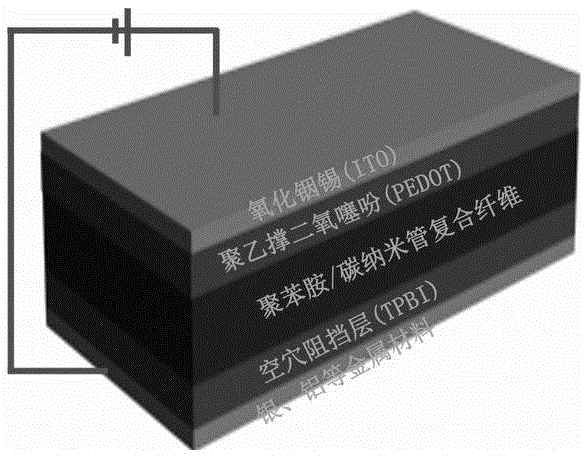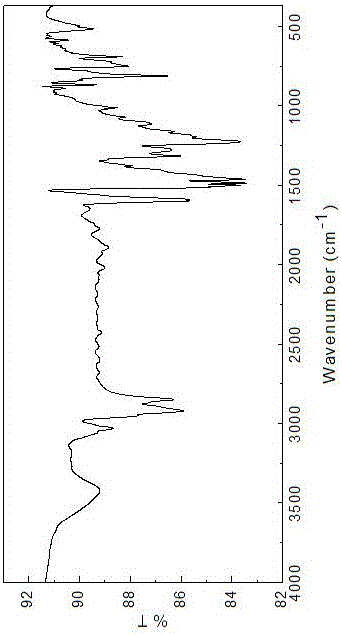Preparation method and application of interpenetrating structure polyaniline/carbon nanotube composite nanofiber material
A carbon nanotube composite and composite nanofiber technology, which is used in semiconductor/solid-state device manufacturing, electrical components, circuits, etc., can solve problems such as color purity decline, and achieve the effects of improving stability, increasing luminous space, and expanding contact area.
- Summary
- Abstract
- Description
- Claims
- Application Information
AI Technical Summary
Problems solved by technology
Method used
Image
Examples
Embodiment 1
[0033] A preparation method of interpenetrating structure polyaniline / carbon nanotube composite nanofiber material, the method comprises: synthesizing polyaniline, adopting Suzuki coupling reaction, using N,N-bis(4-bromophenyl)-4- Synthesis of poly[2,7-(9,9-dioctylfluorene)-alternate-N-phenyl-N-(4-phenoxyphenyl)aniline] from (4-phenoxy)aniline monomer; Preparation Soluble carbon nanotubes; the obtained polyaniline and carbon nanotubes are dissolved in a solvent, and the interpenetrating structure polyaniline / carbon nanotube composite nanofiber material is prepared by high-voltage electrospinning technology, and the electroporation of the interpenetrating structure composite nanofiber material is prepared. luminescent device.
Embodiment 2
[0035] According to the preparation method of the interpenetrating structure polyaniline / carbon nanotube composite nanofiber material described in Example 1, the reaction formula of the synthetic polyaniline is shown in the following formula:
[0036] ,
[0037] The obtained N,N-bis(4-bromophenyl)-4-(4-phenoxy)aniline (Mon) monomer was purified and combined with 9,9-dioctylfluorene-2,7-diboronic acid cis ( 1,3-propylene glycol) ester is polymerized to obtain poly[2,7-(9,9-dioctylfluorene)-alternate-N-phenyl-N-(4-phenoxyphenyl)aniline];
[0038] The specific steps are as follows: using purified toluene as a solvent, wherein 10-25 mL of toluene is added to 1 mmol of aniline monomer, and 9,9-dioctylfluorene-2,7-diboronic acid cis (1,3-propanediol) ester and monomer are used. Mon is added according to the molar ratio of 1:1.0~1:1.1, and the addition ratio is 1:25~1:30 palladium catalyst Pd(PPh 3 ) 4 , the described palladium catalyst Pd (PPh 3 ) 4The ratio of 9,9-dioctylflu...
Embodiment 3
[0040] According to the preparation method of the interpenetrating structure polyaniline / carbon nanotube composite nanofiber material described in embodiment 1 or 2, the obtained polyaniline and carbon nanotubes are dissolved in a solvent, and soluble carbon nanotubes are added. , the content is 0.5~10.0% (wt.%), under the condition of 10~30 ℃, using high-voltage electrospinning technology, adjust the spinning voltage to 10~30kV, and the distance between the transmitter electrode and the receiver electrode is 5~30cm The polyaniline / carbon nanotube composite nanofiber material can be obtained on the receiving electrode by controlling the flow rate of the liquid by using a micro-injection pump. The average diameter of the nanofiber material is 100-700 nm;
PUM
| Property | Measurement | Unit |
|---|---|---|
| The average diameter | aaaaa | aaaaa |
| Dimension length | aaaaa | aaaaa |
| Thickness | aaaaa | aaaaa |
Abstract
Description
Claims
Application Information
 Login to View More
Login to View More - R&D
- Intellectual Property
- Life Sciences
- Materials
- Tech Scout
- Unparalleled Data Quality
- Higher Quality Content
- 60% Fewer Hallucinations
Browse by: Latest US Patents, China's latest patents, Technical Efficacy Thesaurus, Application Domain, Technology Topic, Popular Technical Reports.
© 2025 PatSnap. All rights reserved.Legal|Privacy policy|Modern Slavery Act Transparency Statement|Sitemap|About US| Contact US: help@patsnap.com



